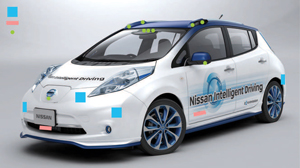|
Nissan maintains two corporate visions of a sustainable mobile society:
zero emission and zero fatality. For zero emission, the company’s
goal is to eliminate the emission of CO2 gases from Nissan vehicles. Zero
fatality is an aspirational goal that aims to eliminate virtually all
fatalities resulting from traffic accidents.
Vehicle intelligence will play a key role in realizing the concept of
zero fatality; therefore, the company is developing an advanced form of
vehicle intelligence called Nissan Intelligent Driving that is composed
of various innovative features. Each feature will be introduced in stages.
In stage 1, Nissan will offer Piloted Drive 1.0 in Japan by the end of
2016, which will allow single-lane autonomous driving under heavy highway
traffic conditions.
Each feature will be introduced in stages.
In stage 1, Nissan will offer Piloted Drive 1.0 in Japan by the end of
2016, which will allow single-lane autonomous driving under heavy highway
traffic conditions.
Nissan Intelligent Driving is centered on performance, comfort, and s
afety to remove stress from the daily commute and minimize risks in unsafe
conditions. Many of these advances are already available, such as
lane-departure warning/prevention and forward emergency braking. During
the next four years, the company will launch multiple vehicles with
autonomous drive technology in Europe, the United States, Japan, and
China. The technology will be installed on mainstream mass-market cars
at affordable prices, and the first model will be offered in Japan this
year. An on-road demo event in Europe in 2016 will showcase the maturity
of Nissan’s autonomous drive technology. The prototype vehicle,
to be tested in actual traffic conditions both on highway and city/urban
roads, is based on the Nissan LEAF electric vehicle and is equipped with
features such as 1-mm wave radar, laser scanners, cameras, high-speed
computer chips, and a specialized human–machine interface. All of
these features, except for setting destination points into the
navigation system, will allow the vehicle to operate in an autonomous
manner both on highway and city/urban roads.
Full article: IEEE Vehicular Technology Magazine, Volume 11, Number 2, June 2016 |